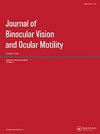Clinical Characteristics of Acquired Diplopia in Adults
Q3 Medicine
Journal of Binocular Vision and Ocular Motility
Pub Date : 2022-10-02
DOI:10.1080/2576117X.2022.2124095
引用次数: 1
Abstract
ABSTRACT Purpose To describe the common causes of symptomatic strabismus and treatment required to resolve diplopia in adult patients seen by one orthoptist. Patients and Methods Retrospective cross-sectional study of consecutive adult patients 18 years or older seen by one orthoptist over a 3-year period with a chief complaint of double vision. Results Two hundred twenty-four consecutive adult patients were examined by the author. Chief complaint was double vision, followed by blurred vision, monocular diplopia, and eye strain. Past ocular histories were significant for early-childhood strabismus in 23 patients. Amblyopia was identified in five patients. Hypertension was a medical risk factor most associated with symptomatic strabismus. Cranial nerve paresis was the most common cause of the strabismus followed by benign, age-related divergence insufficiency esotropia. Prism was the most common treatment in 53% of patients followed by Bangerter foil occlusion in 44 patients (20%). Strabismus surgery was recommended in 11 patients (5%). Manifest refraction was successful in resolving symptoms of binocular diplopia in nine heterophoric patients (5%). Opaque pirate style occlusion was not used for any patient in this series. Conclusions Symptomatic acquired esotropia was a common type of strabismus encountered by the author and trochlear nerve paresis a common cause of symptomatic strabismus in this retrospective cross-sectional study. Press-On™ or ground-in spectacle prism of 12 prism diopters or less resolved diplopia in 124 patients (55%).成人获得性复视的临床特点
摘要目的描述症状性斜视的常见原因以及由一名骨科医生诊治的成年患者复视所需的治疗方法。患者和方法对一名骨科医生连续3年就诊的18岁或18岁以上以复视为主要主诉的成年患者进行回顾性横断面研究。结果作者连续对224例成年患者进行了检查。主要症状是复视,其次是视力模糊、单眼复视和眼睛疲劳。23例儿童早期斜视患者的既往眼史具有重要意义。在5名患者中发现了弱视。高血压是与症状性斜视最相关的医学风险因素。颅神经麻痹是斜视最常见的原因,其次是良性的、年龄相关的发散性内斜视。在53%的患者中,Prism是最常见的治疗方法,其次是44名患者(20%)的Bangerter箔封堵术。建议对11名患者(5%)进行斜视手术。在9名斜视患者(5%)中,明显屈光成功地解决了双眼复视的症状。不透明海盗式封堵术未用于本系列中的任何患者。结论在本回顾性横断面研究中,症状性获得性内斜视是作者常见的斜视类型,滑车神经麻痹是症状性斜视的常见原因。按下™ 124例(55%)患者为12棱镜屈光度或以下分辨率复视。
本文章由计算机程序翻译,如有差异,请以英文原文为准。
求助全文
约1分钟内获得全文
求助全文
来源期刊

Journal of Binocular Vision and Ocular Motility
Medicine-Ophthalmology
CiteScore
1.20
自引率
0.00%
发文量
42
 求助内容:
求助内容: 应助结果提醒方式:
应助结果提醒方式:


